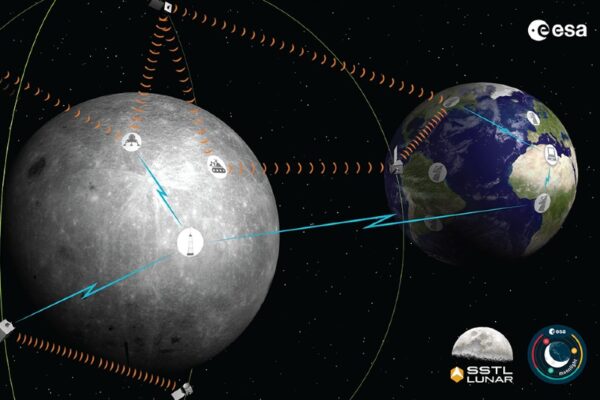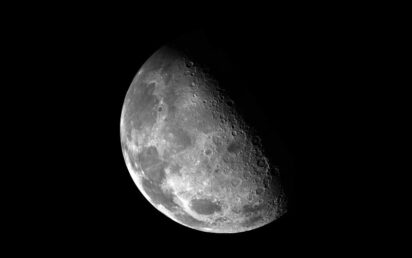UK tech companies are at the heart of plans to return to the Moon.
The first commercial servicing of its kind, Surrey Satellite Technology, Inmarsat and MDA UK are among those who won contracts with the European Space Agency worth just over £2 million to shape the infrastructure for future lunar exploration.
NASA plans to return to the Moon by 2024 and, working with ESA and other partners, intends to put a gateway with living quarters for astronauts in lunar orbit.
Reliable navigation and telecommunication capabilities are essential for these missions, and others like it, to succeed – which is where the UK firms come in.
“People all over the world will be hugely excited by the upcoming missions to the Moon – and I’m proud that UK space companies are leading the way in making these a reality,” said Science Minister Amanda Solloway.
“Britain’s expertise in navigation and telecommunications is second to none and this first of its kind commercial service – spearheaded by some of the UK’s most innovative businesses – demonstrates our ambition for the UK to become a world-leading space nation.”
Under ESA’s Moonlight programme Guildford-based SSTL Lunar will lead a consortium, including Airbus in Portsmouth, Goonhilly Earth Station in Cornwall and Nottingham satellite navigation company GMV-NSL, to plan how they could provide data-relay services for communication and navigation around the Moon.
The study will set out the infrastructure required for the consortiums to deliver a constellation of Lunar communication and navigation satellites which would enable surface missions operating on the far side of the Moon, without a line of sight direct to the Earth, to keep constant contact with Earth.
It will also provide Lunar navigation signals to support the precision landing of scientific equipment and the operation of rovers.
Elodie Viau, ESA’s Director of Telecommunications and Integrated Applications, said: “A lasting link with the Moon enables sustainable space exploration for all our international partners, including commercial space companies.
“By using an ESA-backed telecommunications and navigation service for the Moon, explorers will be able to navigate smoothly and to relay to Earth all the knowledge gained from these lunar missions.”
A robust, reliable and efficient telecommunications and navigation system will make the dozens of individual missions planned for the Moon more cost-efficient and enable smaller countries to become space-faring nations, inspiring the next generation of scientists and engineers.

SSTL’s Managing Director Phil Brownnett said: “Selection for the Moonlight Study is another step forward for our SSTL Lunar team and, together with our consortium partners, we will be bringing a wealth of both innovation and experience to our technical solution.
“Leading the consortium builds on our successful collaboration with ESA for our Lunar Pathfinder communications spacecraft which will provide the world’s first commercial Lunar data relay service after launch in 2022.”
A shared communications and navigation service will also reduce the ticket price of Lunar exploration and reduce the design complexity of individual missions, potentially making them lighter and freeing up space for additional payloads.
Inmarsat, based in London, and MDA Space and Robotics Ltd (MDA UK), based in the Harwell Science and Innovation Campus in Oxfordshire, are part of a consortium led by Telespazio in Italy investigating the development of a Lunar Communications and Navigation Service (LCNS) to support future science, exploration and commercial activities in orbit above, and on, the lunar surface.
Yasrine Ibnyahya, Senior Director, Advanced Concepts and Technologies at Inmarsat, said: “Providing communication and navigation capabilities around the Moon is a major challenge, both technically and commercially. But I strongly believe that the expertise and assets from Inmarsat and our partners can solve this challenge in the most efficient and cost-effective way.
“Communications and navigation are both core capabilities of Inmarsat’s Earth operations in orbit and on the ground, so it is only natural that we expand our reach and leverage our know-how beyond our planet to the Moon.
“This lunar project is only the first step to unlock future opportunities. It can become the hub to facilitate human space exploration, further technology developments and perhaps access to new resources.”
David Kenyon, Managing Director of MDA Space and Robotics Ltd, said: “MDA UK has a long history of supporting commercial and government space missions having most recently successfully delivered the ColKa communication terminal for the International Space Station.
“We are delighted to contribute our expertise as part of this exciting consortium study on the communication and navigation needs of the future lunar economy and hope that our communications technologies, developed in the UK, will form the baseline for this new and innovative service.”
The findings from the latest ‘Size and Health of the UK Space Industry’ report, commissioned by the UK Space Agency and published this week, show income from the UK space sector has risen from £14.8 billion to £16.4 billion, representing growth of 5.7% in real terms, while employment is up by 3,200 from 41,900 to 45,100.


